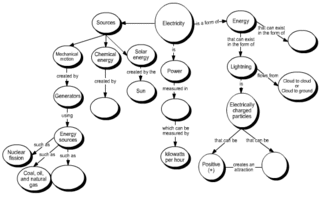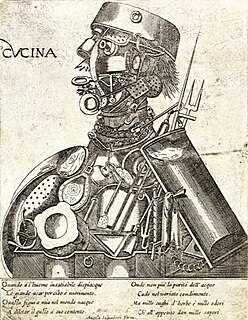Related Research Articles

Educational psychology is the branch of psychology concerned with the scientific study of human learning. The study of learning processes, from both cognitive and behavioral perspectives, allows researchers to understand individual differences in intelligence, cognitive development, affect, motivation, self-regulation, and self-concept, as well as their role in learning. The field of educational psychology relies heavily on quantitative methods, including testing and measurement, to enhance educational activities related to instructional design, classroom management, and assessment, which serve to facilitate learning processes in various educational settings across the lifespan.

Learning theory describes how students receive, process, and retain knowledge during learning. Cognitive, emotional, and environmental influences, as well as prior experience, all play a part in how understanding, or a world view, is acquired or changed and knowledge and skills retained.
Bloom's taxonomy is a set of three hierarchical models used to classify educational learning objectives into levels of complexity and specificity. The three lists cover the learning objectives in cognitive, affective and sensory domains. The cognitive domain list has been the primary focus of most traditional education and is frequently used to structure curriculum learning objectives, assessments and activities.
Activity theory is an umbrella term for a line of eclectic social-sciences theories and research with its roots in the Soviet psychological activity theory pioneered by Sergei Rubinstein in the 1930s. It was later advocated for and popularized by Alexei Leont'ev. Some of the traces of the theory in its inception can also be found in a few works of Lev Vygotsky. These scholars sought to understand human activities as systemic and socially situated phenomena and to go beyond paradigms of reflexology and classical conditioning, psychoanalysis and behaviorism. It became one of the major psychological approaches in the former USSR, being widely used in both theoretical and applied psychology, and in education, professional training, ergonomics, social psychology and work psychology.

A concept map or conceptual diagram is a diagram that depicts suggested relationships between concepts. Concept maps may be used by instructional designers, engineers, technical writers, and others to organize and structure knowledge.
A cognitive tutor is a particular kind of intelligent tutoring system that utilizes a cognitive model to provide feedback to students as they are working through problems. This feedback will immediately inform students of the correctness, or incorrectness, of their actions in the tutor interface; however, cognitive tutors also have the ability to provide context-sensitive hints and instruction to guide students towards reasonable next steps.
Situated cognition is a theory that posits that knowing is inseparable from doing by arguing that all knowledge is situated in activity bound to social, cultural and physical contexts.

Distributed cognition is an approach to cognitive science research that was developed by cognitive anthropologist Edwin Hutchins during the 1990s.
The Knowledge Building (KB) theory was created and developed by Carl Bereiter and Marlene Scardamalia for describing what a community of learners needs to accomplish in order to create knowledge. The theory addresses the need to educate people for the knowledge age society, in which knowledge and innovation are pervasive.
Ecological interface design (EID) is an approach to interface design that was introduced specifically for complex sociotechnical, real-time, and dynamic systems. It has been applied in a variety of domains including process control, aviation, and medicine.
Model-centered instruction is a general theory of instructional design developed by Andrew S. Gibbons. This theory can be used to design individual and group instruction for all kinds of learning in any type of learning environment. In addition, this theory may be used to design instruction with a wide variety of technologies and many media delivery systems.
An intelligent tutoring system (ITS) is a computer system that aims to provide immediate and customized instruction or feedback to learners, usually without requiring intervention from a human teacher. ITSs have the common goal of enabling learning in a meaningful and effective manner by using a variety of computing technologies. There are many examples of ITSs being used in both formal education and professional settings in which they have demonstrated their capabilities and limitations. There is a close relationship between intelligent tutoring, cognitive learning theories and design; and there is ongoing research to improve the effectiveness of ITS. An ITS typically aims to replicate the demonstrated benefits of one-to-one, personalized tutoring, in contexts where students would otherwise have access to one-to-many instruction from a single teacher, or no teacher at all. ITSs are often designed with the goal of providing access to high quality education to each and every student.

Enactive interfaces are interactive systems that allow organization and transmission of knowledge obtained through action. Examples are interfaces that couple a human with a machine to do things usually done unaided, such as shaping a three-dimensional object using multiple modality interactions with a database, or using interactive video to allow a student to visually engage with mathematical concepts. Enactive interface design can be approached through the idea of raising awareness of affordances, that is, optimization of the awareness of possible actions available to someone using the enactive interface. This optimization involves visibility, affordance, and feedback.

The following outline is provided as an overview of and topical guide to thought (thinking):
Adaptive hypermedia (AH) uses hypermedia which is adaptive according to a user model. In contrast to linear media, where all users are offered a standard series of hyperlinks, adaptive hypermedia (AH) tailors what the user is offered based on a model of the user's goals, preferences and knowledge, thus providing links or content most appropriate to the current user.
E-learning theory describes the cognitive science principles of effective multimedia learning using electronic educational technology.

Human–computer interaction (HCI) is research in the design and the use of computer technology, which focuses on the interfaces between people (users) and computers. HCI researchers observe the ways humans interact with computers and design technologies that allow humans to interact with computers in novel ways.
The concept or theory of meaningful learning is that learned information is completely understood and can now be used to make connections with other previously known knowledge, aiding in further understanding. Since information is stored in a network of connections, it can be accessed from multiple starting points depending on the context of recall. Meaningful learning is often contrasted with rote learning, a method in which information is memorized sometimes without elements of understanding or relation to other objects or situations. A real-world example of a concept the learner has learned is an instance of meaningful learning. Utilization of meaningful learning may trigger further learning, as the relation of a concept to a real-world situation may be encouraging to the learner. It may encourage the learner to understand the information presented and will assist with active learning techniques to aid their understanding. Although it takes longer than rote memorization, information is typically retained for a longer period of time.

A pedagogical agent is a concept borrowed from computer science and artificial intelligence and applied to education, usually as part of an intelligent tutoring system (ITS). It is a simulated human-like interface between the learner and the content, in an educational environment. A pedagogical agent is designed to model the type of interactions between a student and another person. Mabanza and de Wet define it as "a character enacted by a computer that interacts with the user in a socially engaging manner". A pedagogical agent can be assigned different roles in the learning environment, such as tutor or co-learner, depending on the desired purpose of the agent. "A tutor agent plays the role of a teacher, while a co-learner agent plays the role of a learning companion".
Cultural-historical activity theory (CHAT) is a theoretical framework which helps to understand and analyse the relationship between the human mind and activity. It traces its origins to the founders of the cultural-historical school of Russian psychology L. S. Vygotsky and Aleksei N. Leontiev. Vygotsky's important insight into the dynamics of consciousness was that it is essentially subjective and shaped by the history of each individual's social and cultural experience. Especially since the 1990s, CHAT has attracted a growing interest among academics worldwide. Elsewhere CHAT has been defined as "a cross-disciplinary framework for studying how humans purposefully transform natural and social reality, including themselves, as an ongoing culturally and historically situated, materially and socially mediated process". Core ideas are: 1) humans act collectively, learn by doing, and communicate in and via their actions; 2) humans make, employ, and adapt tools of all kinds to learn and communicate; and 3) community is central to the process of making and interpreting meaning – and thus to all forms of learning, communicating, and acting.
References
- ↑ Kafai, Y.B. (2006). Constructionism. The Cambridge handbook of the learning sciences. pp. 35–38.
- ↑ Turkle, S. (2004). "Global Technologies as Evocative Objects". Globalization: Culture and Education in the New Millennium (97).
- ↑ Lester, J.C.; FitzGerald, P. J.; Stone, B. A. (1997). "The pedagogical design studio: Exploiting artifact-based task models for constructivist learning". Proceedings of the 2nd International Conference on Intelligent User Interfaces: 155–162. doi:10.1145/238218.238317. S2CID 1654427.
- ↑ "Cognitive Artifacts". The Glossary of Human Computer Interaction. Interaction Design Foundation.
- ↑ Norman, Donald (1991). "Cognitive Artifacts". Designing Interaction: Psychology at the Human-Computer Interface: 17–38.